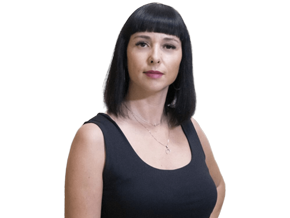Mutxamel, Alicante (Muchamiel in Castillan) is a friendly and sunny town in Spain, located in the north of the Costa Blanca. The distance from Mutxamel to the administrative center is 9 km, and to the nearest airport of Alicante (Aeropuerto Alicante) is 23 km or 15-20 min drive away, and this is very convenient for those who often travel.
The Mutxamel area is pretty small – 47.67 km². At the same time, the number of its inhabitants is 25,645, as at 1 January 2021. The town is really popular: its population has risen to more than 10,000 people compared with the figures of 2001.
A notable fact is that the Valencian dialect is officially spoken and written in Mutxamel, and it is the language that most information on the town could be found in.
Mutxamel is not located on the coast, however, beautiful beaches of another resort town – El Campello are only 8 km or about 13 min drive away.
Mutxamel on the map:
Climate and Weather in Mutxamel, Alicante
Mutxamel has got all the advantages of a Mediterranean climate: almost 330 days of sunshine a year, and the sun shines for 30 days in every summer month. The tourist season runs from late May to October. The average temperature is 27°C in June, 30°C in July-August, 28°C in September and 24°C in October. However, the maximum temperatures during these months can be up to 5°C higher. Torrential rains (locally known as gota fría, which means «a cold drop») are possible in Mutxamel during the first two autumn months. In general, precipitation here is irregular and rare, winters are usually snowless, although a few decades ago, there were several snowfalls in these places.
The History of Mutxamel
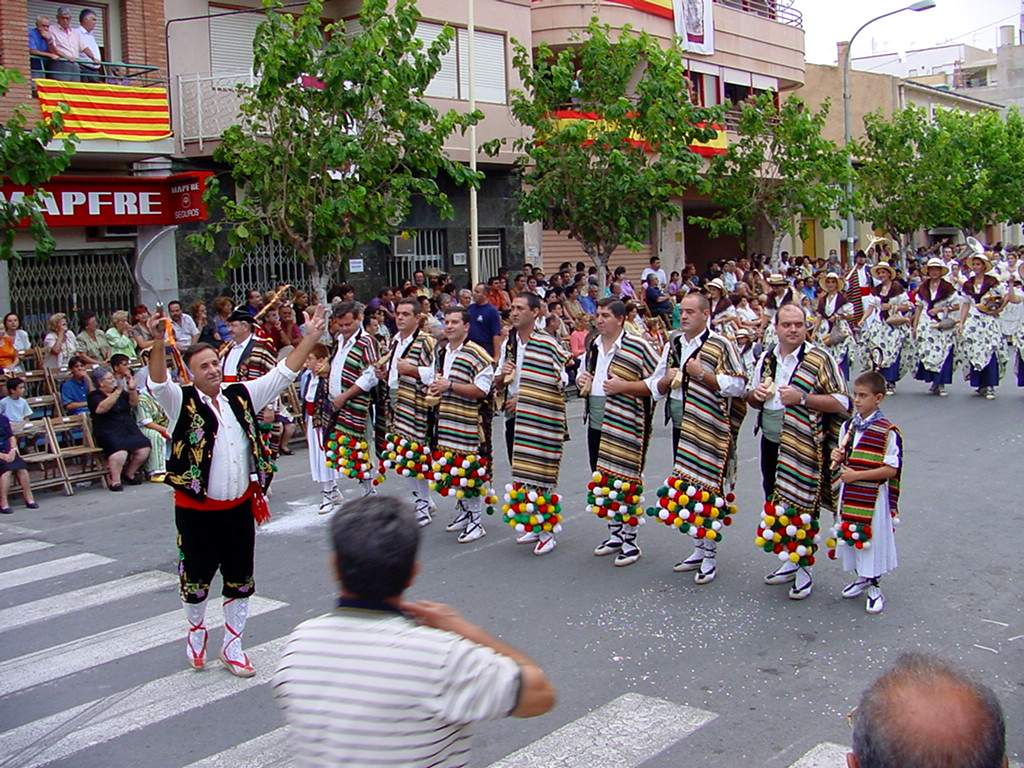
The history of the town of Mutxamel dates back to pre-Christian times and therefore diverse and eventful. There are disputes about the origin name of the resort and several versions are offered. The first one, the most common: this is a literal translation of mucha miel that means «a lot of honey». According to another version, the name is of Arabic ancestry and means «a market place», since Mutxamel always had its own market where anything could be bought: from household utensils to fruits and vegetables.
Namely vegetables – tomatoes have to do with the third version. According to a beautiful ancient legend, once a cart with tomatoes, which owners were carrying for sale, overturned on a road, and a whole heap of ripe vegetables was scattered everywhere. Locals who came to the rescue tried the product and noted its glorious, «honey» taste … Which version is a true story – everyone can choose to his liking, because there is no reliable evidence of any of them.
At the beginning of the XIII century, Christians came to the lands of the present-day town of Mutxamel and colonized local Arab settlements. These important events are reflected by the colorful costumed carnival «Moors and Christians», which is rejoiced with huge celebration throughout the Costa Blanca annually.
For the next half century, Mutxamel belonged to the Castilian crown, at the end of the XIII century, through the efforts of the conqueror James II the Just (Jaime II El Justo), the town territorially passed to the Kingdom of Aragon as part of the Valencian one that gave the Valencian dialect the right to prevail in speech.
During the early XVI century, Mutxamel built its own parish that was a significant for the settlement status in those days. And less than a hundred years later, the Embalse de Tibi was dammed in the town that solved the problem of watering these fertile, but constantly suffering from a moisture deficit lands.
Already by the beginning of the XVII century, Mutxamel received the official status of an administrative settlement with the right to create its local authorities and in the middle of the XVII century, the municipality became a part of Alicante.
The wonderful climate, rich soils, an abundance of fruits and flowering trees prompted the noble classes from Alicante to build country houses and residences here, some of which have survived through the ages and adorn the architecture of Mutxamel.
Since the beginning of the 90s of the last century, the town became entitled to an official name in Valencian – Mutxamel, but the traditional Spanish spelling Muchamiel is also valid, although used mainly outside the municipality.
Attractions of Mutxamel

A walk along Mutxamel will gift a great amount of positive emotions: this town is simply steeped in ancient history, which is reflected in its beautiful buildings and wonderful green parks. Walking along the narrow and winding streets of the old town, one can endlessly admire the architectural variety of houses.
The traditional buildings are characterized by gable roofs, Arabic tiles and large cornices adorned with variegated tiles or decorative «voladissos» stones. Another nice location worth visiting is an ancient church – Església del Salvador with its graceful chapel or a defensive tower, which offer breathtaking views of well-tended estates, delightful gardens and endless sea.
Walk through the well-maintained and crowded squares of Mutxamel, visit its unique neoclassical palace located in El Poble Nou, the historic district of Ravalet, admire the small Arabic-style houses, stroll along the luxurious Alameda promenade ( El Paseo de la Alameda) with its mighty century-old cypresses, take your kids to the play area next to the House of Culture, explore the library building and enjoy the magnificent El Parque Municipal and much more!
On Wednesdays, all guests and locals of Mutxamel go to the market, one of the most popular places in the town. And this is not surprising, because a real gastronomic paradise can be found there: fresh and fragrant bread from a wood-fired oven, a variety of homemade sausages, traditional sweets, colorful fruits and vegetables from local gardens and goods of local craftsmen.
Even the most demanding gastronome will not resist the variety of cuisine in the local cafes, restaurants and bars, and rich cultural programs and numerous holidays throughout the year will not let anyone get bored whenever you come here.
And now, let’s talk about some of these attractions in more detail.
The Church of Saint Salvador (Església del Salvador), Mutxamel

The construction of this church at the beginning of the XVI century marked the end of religious visits to the neighboring town of San Juan by local inhabitants. The construction works were completed only a century later, and the church was dedicated to the revered saint here – Salvador.
Now, this building is considered as the most important religious structure of Mutxamel. The exterior of the temple is distinguished by a mixture of architectural styles and includes elements of baroque and neoclassicism. The structure forms a Latin cross with three chapels. One of the chapels dedicated to the patroness of the town, the Virgin of Loreto – Mare de Deu de Loreto, was originally located in the basement of the bell tower, and this is a fine example of the presence of the Renaissance in the province of Alicante.
A gothic tower of Mutxamel is also noteworthy, currently serving as the second bell tower, and in former times it had the function of alerting and protecting the population of the town from dangerous pirate robberies. The height of the tower is impressive – 23.5 meters, and each of its five floors has its own architectural solution.
Opening hours of Església del Salvador
- Tuesday-Sunday from 11:30 to 12:30
- Monday-Sunday from 18:00 to 20:00
The Nova Square (Plaza Nova)

This is a special symbolic place in the religious, festive and everyday life of the inhabitants of Mutxamel, where all the action is: parades in honor of the Moors and Christians smoothly shift into solemn processions in honor of the Holy Virgin – Mare de Deu Loreto.
In the XIX century, this square was known as La Placa de la Illeta and it was a favorite meeting place for citizens, where they gathered to fetch water, and at the same time to catch up on the latest gossip. This is the old town center of Mutxamel, which extends to another famous area – Ravalet. The houses located here are made in a traditional style: tiled gable roofs, high cornices with patterns, and in some places cozy green gardens. Throughout its history, the Nova Square has undergone numerous changes, the last of which date back to 2002, but it has always remained a culturally significant Mutxamel’s site.
The House of Ferraz (Casa Ferraz)
This beautiful house, which can be seen on the square Placa Sant Roc, belonged to the noble family Ferraz Alcalá Galiano, Marqueses de Amposta. Its most interesting element is a tower built in masonry, the purpose of which was to defend its inhabitants from attacks by Berber pirates. The special charm of the Ferraz house is given by its gardens, called Santa Elena and an impressive entrance door with a family shield at the top.
The Ferraz House is a private property and tourists will be able to admire it only from the outside.
The Monastery of San Francisco (Convento de San Francisco)

For more than two hundred years, it has been a bulwark for Mutxamel both on a spiritual and religious level.
In 1605, this monastery was founded by the monk San Francisco de Paula who then called his brethren there. The first residence of their brotherhood was located in the Hermitage of La Mare de Montserrat, and later it moved to this building, which became their final refuge and modern monastery. In 1642, a Franciscan church was located here and religious services began to take place regularly. Currently, there are no more daily prayer services, but a religious mass is held once a month. To get into the San Francisco Monastery, one has to visit this mass.
The Ravalet District
It is an important part of the historical center of Mutxamel. Together with another famous area, Poble Nou, they were once considered separate settlements, each of them even had their own school, which functioned until the 70s.
The location of houses around the square, their architecture, tiled roofs, traditional facade colors and narrow streets indicate their Arab origins. With the arrival of the Catalan-Aragonese conquerors, the Muslim population became much smaller, and the town began to acquire a new look, retaining the influence of Arab culture.
This district is now fully integrated into the social life of Mutxamel. Its own traditions and uniqueness are reflected in the preservation of its own festivals, celebrated a few days before the famous «Moors and Christians» in September, and in the same square, a favorite meeting place for its former inhabitants.
Peñacerrada Gardens (Jardines de Peñacerrada)

This place decorating the town center of Mutxamel includes a magnificent palace surrounded by a well-tended garden. Once the palace of Peñaserrada had its own town hall and even formed a separate settlement, until it became part of Mutxamel in the Poble Nou area on 1 January 1846. There are no proper documents confirming the exact date of the construction of the palace at the end of the XVII century, but its late Baroque style clearly points to the time. The building consists of two clearly separated parts. One of them is the old palace overlooking the square, the second building is the new palace located on the east side and adjacent to the garden.
Other houses, centered around the Plaza del Poble Nou, were formerly accommodations of the Marquis of Peñaserrada servants, and he was an owner of this unique neoclassical palace.
An interesting detail: the facade of the palace, which can be seen from the square, is by no means the most colorful, since this view was intended by the Marquis for his own servants. But in the corner of the wall, lined with stone blocks, one can admire the noble shield with the symbols of this rich family.
In the old gardens that flank the building of the palace, there is a mixture of European styles – French, English and Italian architecture. It is no coincidence that since 24 January 2008, the palace and gardens of Peñaserrada have been classified as a cultural heritage of Valencia.
Tourists will not be allowed to get inside the palace, since this is private property.
Peñacerrada Gardens is one of the most beautiful architectural complexes of the Huerta de L’Alacanti area.
The garden covers approximately 2 hectares. The prevailing European styles include French, English and Italian.
The French garden is distinguished by low flower beds, symmetrically framed by myrtle. In front of the facade of the palace, one can see a whole pyramid in this style and several cypress trees, trimmed in the form of an arch.

The English garden corresponds to the romantic style: it consists of an impromptu forest, two artificial mountains connected by a bridge, a turret, a grotto and a cozy old house.
In the Italian garden, one will be greeted by eight stone columns and a small pool of clear water, all surrounded by fragrant cypress trees.
The fourth, Latin-American style is also presented in the gardens. It features a traditional irrigation system that irrigates the entire garden from a large pool located at the top of the garden. This pool, surrounded by huge cypresses and comfortable benches, had three main functions: to water the plants, supply the palace with water and serve as a recreation area for the household.
Opening hours of Los Jardines de Peñacerrada:
- Sunday from 10:00 to 14:00.
- Closed from 1 July to 25 September.
The Hermitage of Montserrat (Ermita de Monserrat)
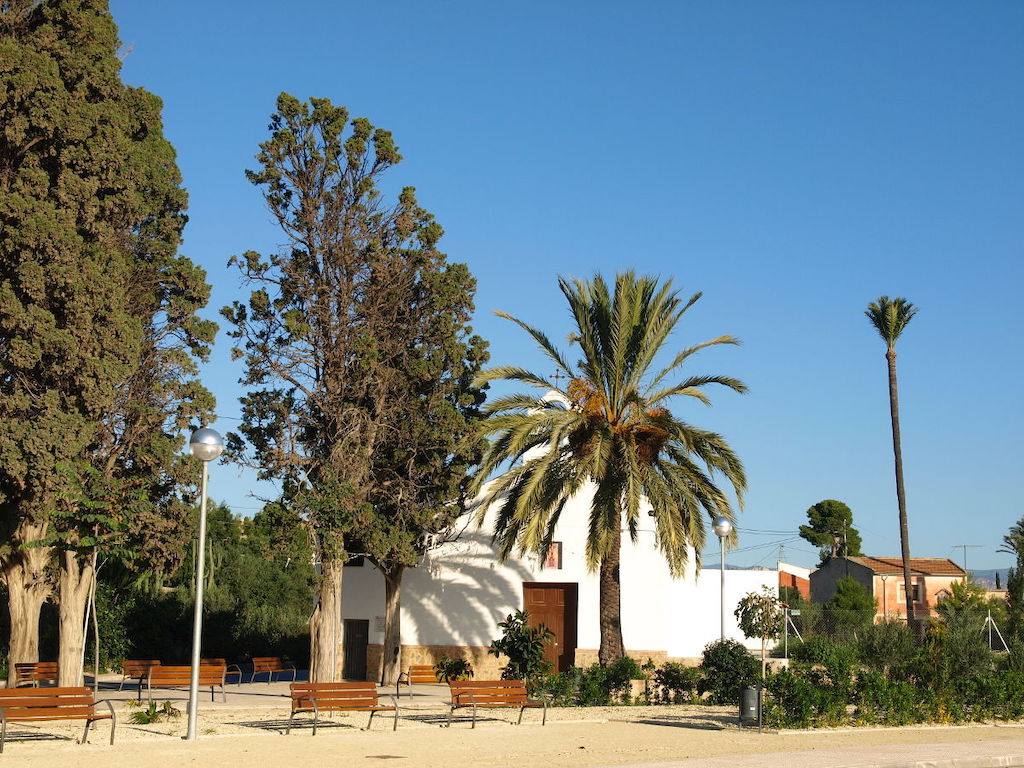
The building is one of the most beautiful and at the same time functional places on the territory of the Mutxamel Gardens. In the old days, after a strong storm, the bells of the Hermitage of Montserrat announced to farmers that they could come here and take on water for irrigation of their lands.
The construction of the Hermitage dates back to the XVI century: initially it was the residence of monks who later moved to the monastery of San Francisco.
Talking about the Montserrat Hermitage and its surroundings creates among inhabitants pleasant associations with a series of September holidays in honor of the Virgin of Montserrat, also known as la Moreneta.
The Calvary Hermitage (Ermita del Calvario)
Located in the Sierra del Calvario area and built in the middle of the XVIII century, the Hermitage of Calvary is shaped as a Greek cross, covered in the central part with an octagonal dome. From its comfortable elevated position, a wide view of the gardens and the sea, as well as views of Mutxamel are opened. The cypress road leads to the Hermitage, along which pilgrims march on Good Friday. There is also a cozy recreation area with barbecue in the vicinity of the Calvary Hermitage.
The San Antonio Hermitage (Ermita de Sant Antoni)
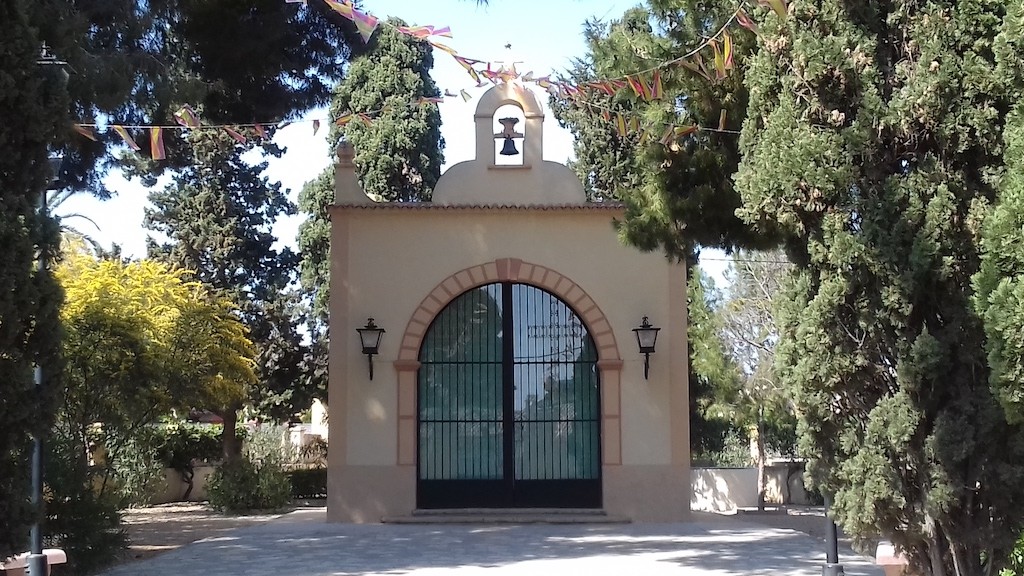
It was built around 1722 and rebuilt in 1956. Once there was an old municipal cemetery here, and now a holiday in honor of the saint patron of animals – San Antonio Abad is celebrated here annually, on 17th January. On these dates, a spectacular equestrian parade from all over the region can be seen throughout the Hermitage, as well as other domestic animals that are brought here to celebrate the day of their reliable patron.
The Assuts Irrigation System in Mutxamel
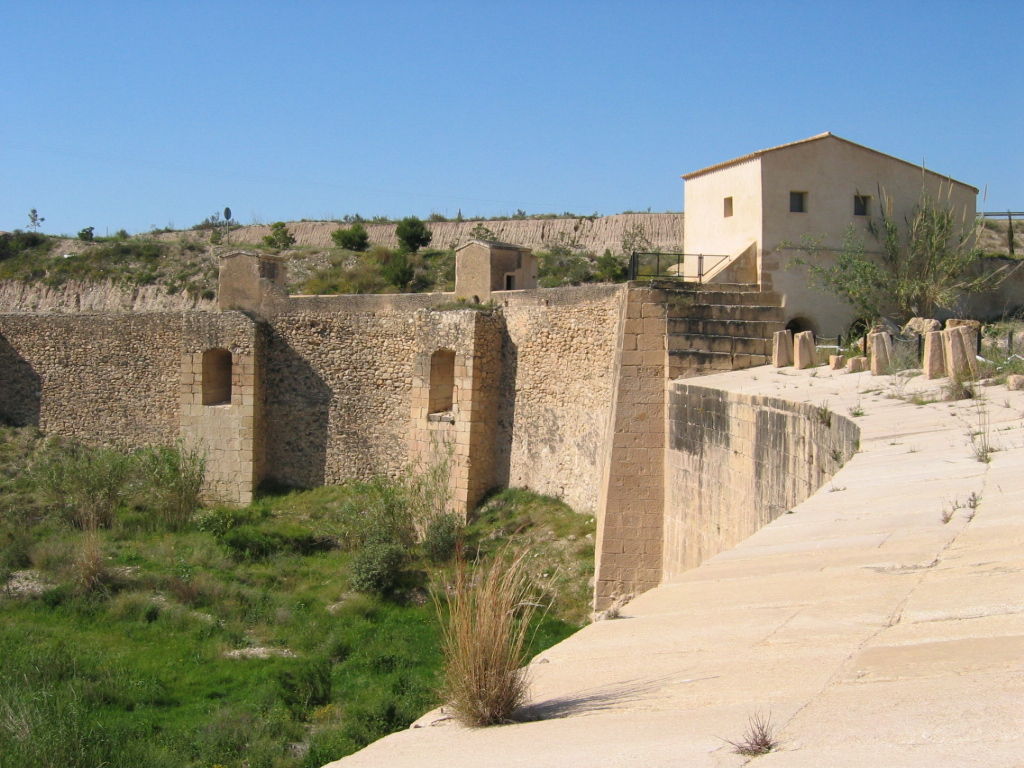
The system is of Islamic origin and based on the use of the waters of the Monnegre River and other nearby water sources. New Christian settlers in the XIII century adopted this system and used it to irrigate their agricultural lands.
The constructed dams served well until the XIX century, and at the present time they are still in good working order.
Waters from the irrigation system was supplied to various parts of agriculture in the Huerta de Alicante area. There was also a special communication system, which helped to warn in time about available water by ringing bells. Another way to announce irrigation water entering was shooting up in the air.
The Byzantine Art Museum (Museo Arte Bizantino) in Mutxamel
This art museum is located in the building of the Trinidad Monastery. The museum was built in the period from the XVII to the XVIII century, then it underwent changes and renovations during the second half of the XIX century, and later it was transformed one more time by monks from the Brotherhood, who lived there from 26 October 1982. Today, the Byzantine Art Museum is directing most of its efforts at preserving the literary heritage of the Byzantine period, it carries out reconstructions and makes reproductions of icons, some of which were painted using the oldest, now lost techniques.
Opening hours of Museo Arte Bizantino:
- Tuesday from 16:00 to 18:00
- Saturday from 10:00 to 13:00
- Sunday from 9:30 am to 11:30 am
Works by Arkadi Blasco (Obras de Arcadi Blasco)
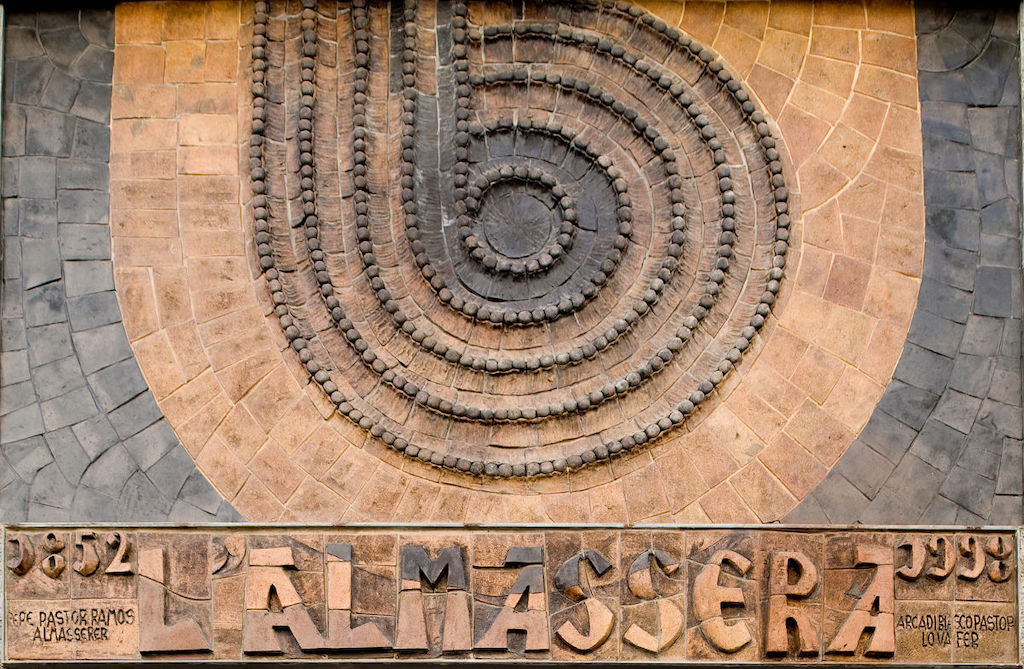
Arcadi Blasco Pastor (Mutxamel, 1928-2013) is a well-known artist who has made considerable efforts to popularize the culture of Alicante through various initiatives, that included his ceramic works and teaching others in this art. His creations are represented in urban sculptural ensembles, impressing with their imposing shapes and bas-reliefs. In Mutxamel we can see the following:
- The fountain Torre Vigía, 2001. The fountain is an allegory of numerous defensive towers that are located along the coast, and act as a symbol of harmony between different religious denominations, represented by four chapels located on each side of the fountain. The fountain is installed at the roundabout, on the Carlos Soler Avenue.
- Mural Almassera, 1999 is located on the street El Fossar, where an «almassera» itself (literally: the place where an olive turns into oil) is found, where this amazing fresco can be seen.
- Mural Guernica, 2009. The fresco was performed by the students of the school under the guidance of Arkadi Blasco at the time when he conducted his training seminars. Guernica is a town and municipality in Spain, province of Biskay, within the autonomy of the Basque Country.
The Municipal Park El Canyar de les Portelles in Mutxamel, Spain
In the center of Mutxamel there are the «green lungs» of the town, which are nothing else than the municipal park of El Canyar de le Portelles. It is located opposite the House of Culture, being a the picturesque part of nature inside the urban municipality. Here one can take a break in a harmonious and cozy atmosphere, take a walk in the fresh air or take part in one of the outdoor activities regularly organized by the local municipality.
The l’Aguila Park (Parque de l’Aguila)
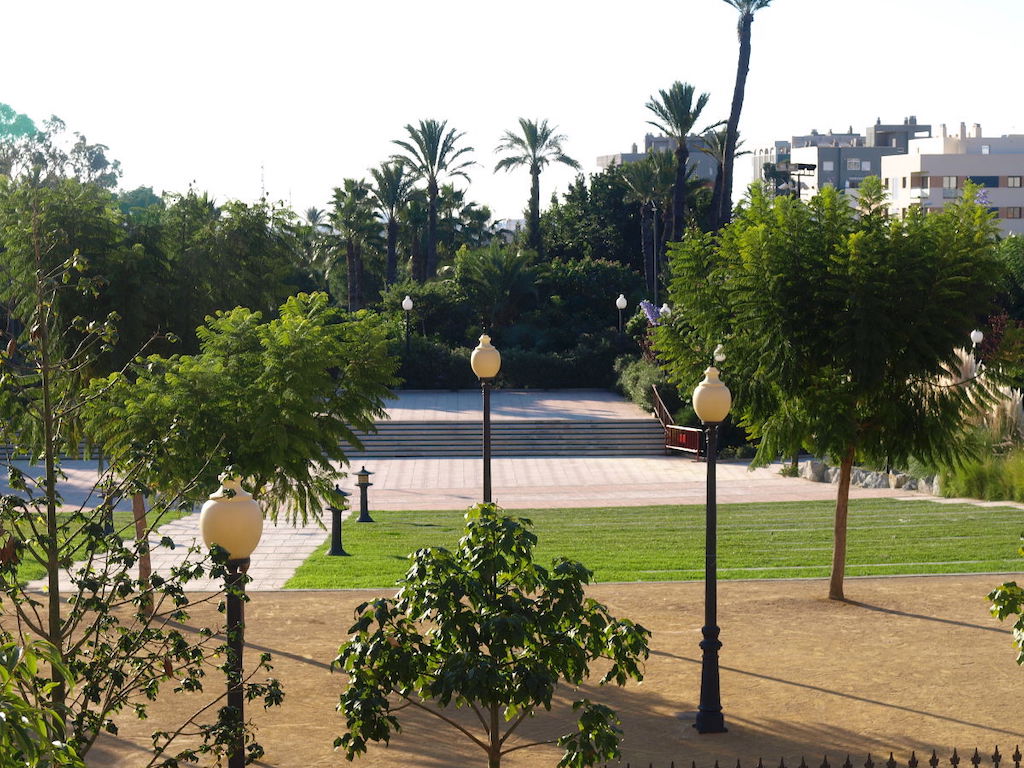
This unique natural area that protected by the Valencia Conservation Committee is located northeast of Mutxamel. It is a perfect place for recreation, hiking and cycling, with its area of 1,114 hectares.
There are rare and endangered plants here, as well as shrubs and pines that must be preserved. Considering the above, there are some restrictions in the park:
- It not allowed to leave existing tracks;
- No bonfires are allowed;
- Restrictions on entry;
- Any agricultural and other works on the territory are prohibited.
Gastronomy in Mutxamel, Alicante
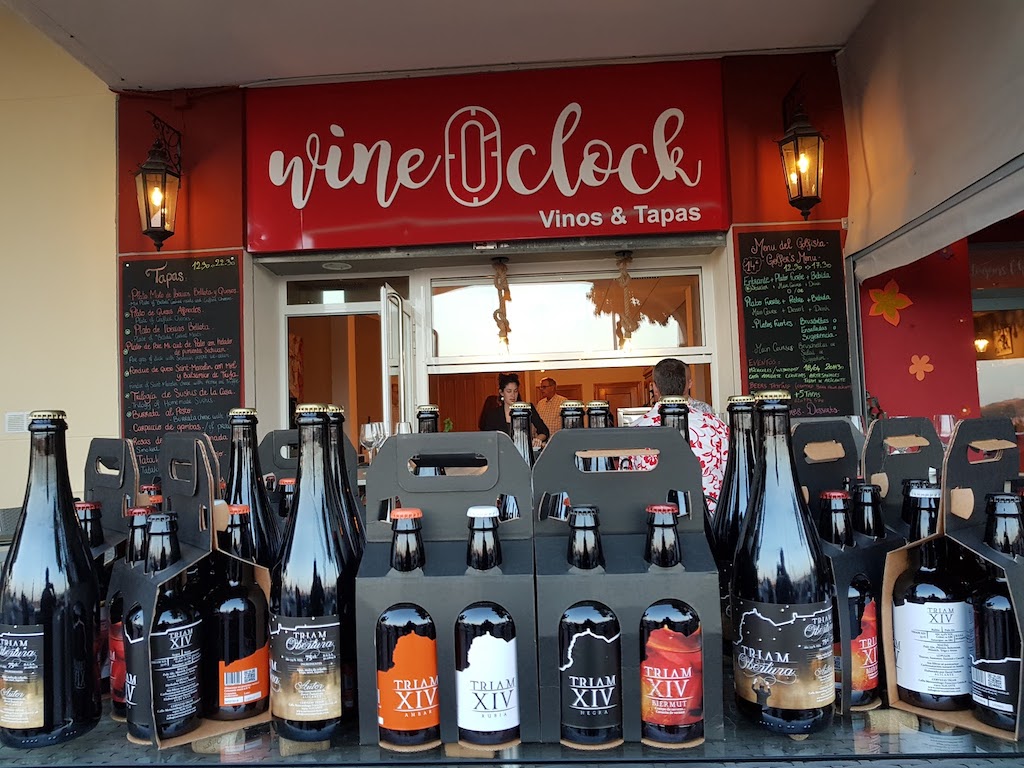
If you are tired of walking through the parks, museums and palaces of Mutxamel, then it is as good time to be pampered with something delicious. What kind of establishments can Mutxamel offer?
Let’s start with the restaurant La Perla. French, Mediterranean and European cuisines are presented here. One can enjoy delicious seafood: oysters, mussels, shells, shrimps, langoustines, scallops and even snails (hello, France!) – all this variety can turn out to be one big tasty set on your table. Freshly cooked fish or juicy steak can be also tried in this restaurant.
Address: Calle Vespre Bonalba, 03110 Mutxamel
The restaurant Wine O’Clock will offer you a lounge bar, including a wine bar, and dishes of European and Spanish cuisine. Visitors note the presence of vegetarian dishes, a wonderful assortment of local cheeses meat products. Desserts and homemade wine are also good here. Visitors can enjoy their meal accompanied by live music.
- Address: Calle Vespre 5, 03110 Mutxamel
True connoisseurs of Asian cuisine should visit Lidu. A variety of Chinese dishes, fusion cuisine and vibrant avant-garde décor await you at this establishment. Sushi, traditional soups and noodles, gourmet seafood dishes, almond chicken are just a small part of the restaurant’s assortment. And, of course, the menu of the day for 10 euros – in the finest traditions of all Chinese restaurants.
- Address: Calle de l’Arquitecte Antoni Gaudi 1 | Local 1, 03110 Mutxamel
Those who cannot imagine their rest without a noisy nightlife and wish to freshen up with a bright cocktail – they should go to one of the many bars in Mutxamel:
- Pub ESSEN: Calle Felipe Anton 26, 03110 Mutxamel
- Bar Simon: Pasaje Pilar Beltri 87, 03110 Mutxamel
- Bar El Toreo: Av. Alfonso XII, 03110 Mutxamel
Active leisure in Mutxamel, Spain
For lovers of outdoor activities, Posidonia Ecosports offers its services on Barrella street 4 local 2 Mutxamel, where visitors will be offered:
- Boat tours and water sports.
- Active games in the open air.
- Scuba diving or snorkelling, etc.
Prestigious and exciting golf courses await you here:
- Club De Golf Bonalba at Partida Bonalba s/n, Mutxamel.
Holidays in Mutxamel, Alicante
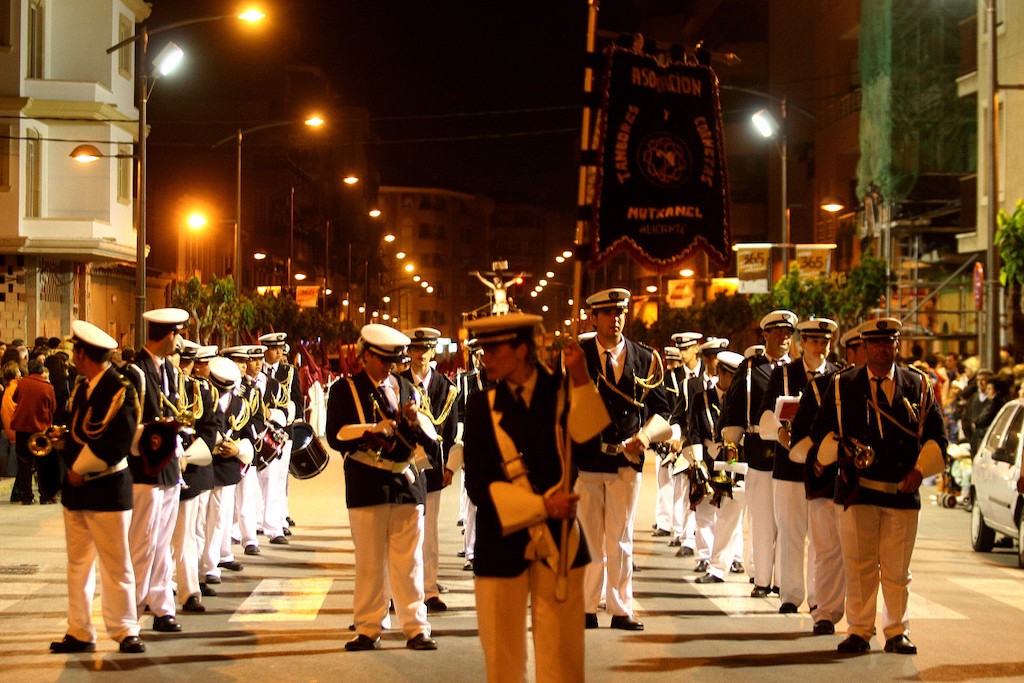
It is impossible to take no notice of holidays, which are a great many in Mutxamel.
- 5th January – Cavalcade of Magic Kings (Cabalgata de los Reyes Magos). This is a bright and noisy procession, accompanied by original carnival costumes, music and dances.
- 17th January – the Day of San Antonio Abad. This festival has been celebrated in Mutxamel for almost a century. It is an agricultural festival accompanied by a blessing of bread and a magnificent equestrian parade. Music, dances, bonfires and fireworks – such a colorful show will live long in your memory.
- 1th March – Celebration of the Miraculous Tearing (Milagro de la Lágrima). On this day, the inhabitants of Mutxamel thank their beloved patroness, the Virgin of Loreto, for the miracle performed in the middle of the XVI century, when a blessed rain was sent and the harvest was saved in response to the prayers. The holiday begins with a morning offering of flowers, continues with a solemn procession and ends with a Christian Mass, accompanied by a church choir. Up to 5,000 people actively participate in this celebration.
- In April, residents of Mutxamel celebrate the Easter Holy Week (Semana Santa). The Easter holiday begins with the Cross Procession on Palm Sunday, which moves along the elegant streets, bypassing the monastery and heading towards the church. On Wednesday, members of Christian monastic fraternities begin their penitential processions from the San Francisco monastery and the Temple of El Salvador, and then these processions meet emotionally. The oldest traditional procession takes place on Good Friday, when monks from four different Christian brotherhoods can be seen in the streets of Mutxamel at night. On Easter Sunday, in the early hours of dawn, everything ends with the «Procession of the Meeting», when the inhabitants of Mutxamel accompany their patron saint, the Virgin Loreto, to the temple dedicated to her.
- The first Saturday in May – the Feast of the May Cross (Fiesta de la Vera Creu). May is a great time to get out of the house. The fields are full of flowers, which the inhabitants of Mutxamel use to decorate their symbolic «crosses». This important date marks the beginning of the traditional cycle of street dancing in the town. The Ravalet quarter is the very place where this tradition has been strictly observed for many years: all the neighbors get together and, to the sound of a pipe and drums, arrange incendiary dances, carrying crosses decorated with colorful flowers. The festive procession ends in front of the Montserrat Chapel, where the main symbol of May is solemnly hoisted.
- 6th August – Fiesta del Salvador – holiday in honor of the revered saint, to whom the church of the same name is dedicated.
- 7-13th September – the Moors and Christians (Moros y Сristianos) – the favorite and, perhaps, the most recognizable carnival, which attracts a huge number of tourists.
- 9th September is dedicated to religious cults, flower offerings, mass choral singing and is marked by a magical night procession that runs through the main streets of Mutxamel. A magnificent concert organized in the park becomes a bright musical end of this unusual day.
- 10th September 10 is the most anticipated day for the participants of the holiday, with the solemn entry of the «Moors» and «Christians», who worked for a whole year and made joint efforts for this large-scale theatrical performance. The magic of acting, the splendor of the costumes of the Moorish and Christian captains, general jubilation, noise, laughter, music: words could never express all the splendor of this unique art show, which is presented every year in a new way. These unforgettable days are lived by participants and observers during three eventful days on 10, 11 and 12th September.
Real Estate in Mutxamel, Alicante

Mutxamel, with its amazingly eventful life, charming ancient architecture and fragrant gardens, it is a special place that you cannot forget and want to return again and again. For those who would like to buy their own home here, there is a wide selection from luxury homes in historic buildings to small apartments in the town center. Luxurious villas and mansions with magnificent views of the sea, the town’s architectural monuments, blooming gardens and emerald golf courses are also always in demand.
Who is this town for? First of all, for those who are looking for a beautiful, quiet place to live, away from the noise of popular tourist cities, with affordable real estate and all the infrastructure necessary for comfortable life. So, Mutxamel is ideal for permanent family residence. The town is located in close proximity to the sea (about 8 km) and from the major resorts of the Costa Blanca, for example, Alicante (12 km). One of its main advantages is relatively low property prices.
According to idealista.com for November 2021, the average cost of housing in Mutxamel is 1.237 €/m2. The most expensive areas are Bonalba-Cotoveta – 1.548 €/m2 near golf courses and Almajada-Ravel – 1.348 €/m2, which offers perfect views of the sea coast from the hill.
The more budgetary areas include the Centro district – 1.091 €/m2, where all the infrastructure will be within walking distance and Valle del Sol – 1.283 €/m2.
The property prices in Mutxamel start from 36.000 € for studios or 1.171 eur/m² for apartments. A cozy chalet can be purchased from 70.000 €, a modern duplex – from 134.000 €, an independent house with a private pool – from 125.000 €.
You can get acquainted with our real estate offers in our catalog or contact our specialists – they will be happy to help you in choosing the best option.


